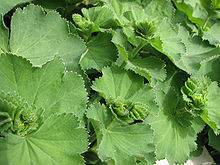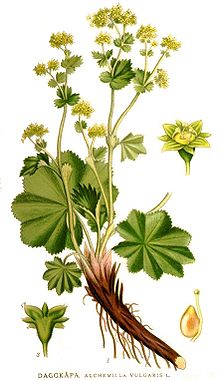
Back كمالية (نبات) Arabic رجل الاسد ARZ Şaxduran Azerbaijani Raskėls BAT-SMG Гусялапка Byelorussian Шапиче Bulgarian Alquemil·la Catalan Alchemilla CEB Kontryhel Czech Mantell Fair Welsh
This article needs additional citations for verification. (January 2022) |
| Alchemilla | |
|---|---|

| |
| Alchemilla vulgaris | |

| |
| Botanical illustration of Alchemilla vulgaris | |
| Scientific classification | |
| Kingdom: | Plantae |
| Clade: | Tracheophytes |
| Clade: | Angiosperms |
| Clade: | Eudicots |
| Clade: | Rosids |
| Order: | Rosales |
| Family: | Rosaceae |
| Subfamily: | Rosoideae |
| Tribe: | Potentilleae |
| Subtribe: | Fragariinae |
| Genus: | Alchemilla L. |
| Type species | |
| A. vulgaris | |
| Species | |
|
See text | |
| Synonyms[1] | |
| |
Alchemilla is a genus of herbaceous perennial plants in the family Rosaceae, with the common name lady's mantle applied generically as well as specifically to Alchemilla mollis when referred to as a garden plant. The plant used as a herbal tea or for medicinal usage such as gynaecological disorders is Alchemilla xanthochlora or in Middle Europe the so-called common lady's mantle Alchemilla vulgaris. There are about 700 species, the majority native to cool temperate and subarctic regions of Europe and Asia, with a few species native to the mountains of Africa and the Americas.[2]
Most species of Alchemilla are clump-forming or mounded perennials with basal leaves arising from woody rhizomes. Some species have leaves with lobes that radiate from a common point and others have divided leaves—both are typically fan-shaped with small teeth at the tips. The long-stalked, gray-green to green leaves are often covered with soft hairs, and show a high degree of water-resistance (see Lotus effect). Green to bright chartreuse flowers are small, have no petals and appear in clusters above the foliage in late spring and summer.
- ^ "Alchemilla L." Plants of the World Online. Royal Botanic Gardens, Kew. Retrieved 14 January 2022.
- ^ "Alchemilla L." Atlas of Living Australia. Archived from the original on 2018-08-31. Retrieved 2018-02-11.